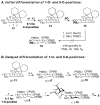Chemical synthesis and functionalization of clickable glycosylphosphatidylinositol anchors
- PMID: 22163072
- PMCID: PMC3233219
- DOI: 10.1039/C1SC00440A
Chemical synthesis and functionalization of clickable glycosylphosphatidylinositol anchors
Abstract
Glycosylphosphatidylinositol (GPI) anchorage is a common posttranslational modification of eukaryotic proteins. Chemical synthesis of structurally defined GPIs and GPI derivatives is a necessary step toward understanding the properties and functions of these molecules in biological systems. In this work, the synthesis of several functionalized GPI anchors was accomplished using the para-methoxybenzyl (PMB) group for permanent hydroxyl protection, which allowed the incorporation of functionalities that are incompatible with permanent protecting groups traditionally used in carbohydrate synthesis. A flexible convergent-divergent assembly strategy enabled efficient access to a diverse set of target structures, including "clickable" Alkynyl-GPIs 1 and 2 and Azido-GPI 3. For global deprotection, a one-pot reaction was employed to afford the target GPIs in excellent yields (85-97%). Fully deprotected clickable GPIs 2 and 3 were readily conjugated to imaging and affinity probes via Cu(I)-catalyzed and Cu-free strain-promoted [3+2] cycloaddition, respectively, resulting in GPI-Fluor 4 and GPI-Biotin 5.
Figures















Similar articles
-
Synthesis of a Bifunctionalized Glycosylphosphatidylinositol (GPI) Anchor Useful for the Study of GPI Biology.Chemistry. 2023 Mar 22;29(17):e202203457. doi: 10.1002/chem.202203457. Epub 2023 Feb 17. Chemistry. 2023. PMID: 36445784 Free PMC article.
-
Synthetic Studies of Glycosylphosphatidylinositol (GPI) Anchors and GPI-Anchored Peptides, Glycopeptides, and Proteins.Curr Org Synth. 2013 Jun 1;10(3):366-383. doi: 10.2174/1570179411310030003. Curr Org Synth. 2013. PMID: 24955081 Free PMC article.
-
Synthesis of a Glycosylphosphatidylinositol Anchor Derived from Leishmania donovani That Can Be Functionalized by Cu-Catalyzed Azide-Alkyne Cycloadditions.Org Lett. 2017 Jul 21;19(14):3827-3830. doi: 10.1021/acs.orglett.7b01703. Epub 2017 Jul 11. Org Lett. 2017. PMID: 28696125 Free PMC article.
-
Chemical biology of glycosylphosphatidylinositol anchors.Angew Chem Int Ed Engl. 2012 Nov 12;51(46):11438-56. doi: 10.1002/anie.201203912. Epub 2012 Oct 19. Angew Chem Int Ed Engl. 2012. PMID: 23086912 Review.
-
Recent research progress in glycosylphosphatidylinositol-anchored protein biosynthesis, chemical/chemoenzymatic synthesis, and interaction with the cell membrane.Curr Opin Chem Biol. 2024 Feb;78:102421. doi: 10.1016/j.cbpa.2023.102421. Epub 2024 Jan 4. Curr Opin Chem Biol. 2024. PMID: 38181647 Free PMC article. Review.
Cited by
-
Recent progress in synthetic and biological studies of GPI anchors and GPI-anchored proteins.Curr Opin Chem Biol. 2013 Dec;17(6):1006-13. doi: 10.1016/j.cbpa.2013.09.016. Epub 2013 Oct 12. Curr Opin Chem Biol. 2013. PMID: 24128440 Free PMC article. Review.
-
Diversity-Oriented Synthesis of Glycosylphosphatidylinositol Probes Based on an Orthogonally Protected Pentasaccharide.Org Lett. 2023 Mar 31;25(12):2088-2092. doi: 10.1021/acs.orglett.3c00448. Epub 2023 Mar 20. Org Lett. 2023. PMID: 36939185 Free PMC article.
-
Synthesis of a Bifunctionalized Glycosylphosphatidylinositol (GPI) Anchor Useful for the Study of GPI Biology.Chemistry. 2023 Mar 22;29(17):e202203457. doi: 10.1002/chem.202203457. Epub 2023 Feb 17. Chemistry. 2023. PMID: 36445784 Free PMC article.
-
A Not-So-Ancient Grease History: Click Chemistry and Protein Lipid Modifications.Chem Rev. 2021 Jun 23;121(12):7178-7248. doi: 10.1021/acs.chemrev.0c01108. Epub 2021 Apr 6. Chem Rev. 2021. PMID: 33821625 Free PMC article. Review.
-
Reviewing Glycosyl-Inositols: Natural Occurrence, Biological Roles, and Synthetic Techniques.Chembiochem. 2025 Mar 15;26(6):e202400823. doi: 10.1002/cbic.202400823. Epub 2025 Mar 2. Chembiochem. 2025. PMID: 40025679 Free PMC article. Review.
References
Grants and funding
LinkOut - more resources
Full Text Sources

